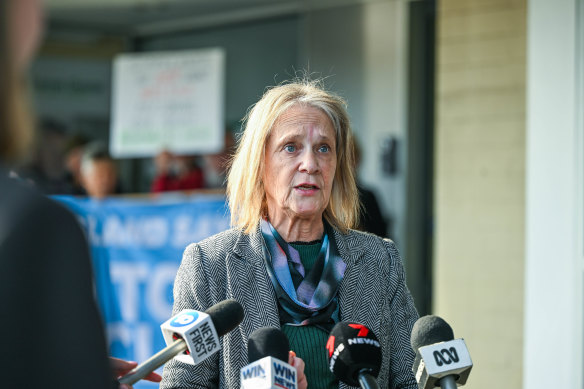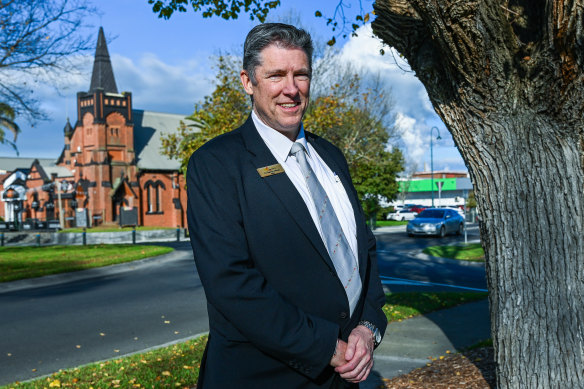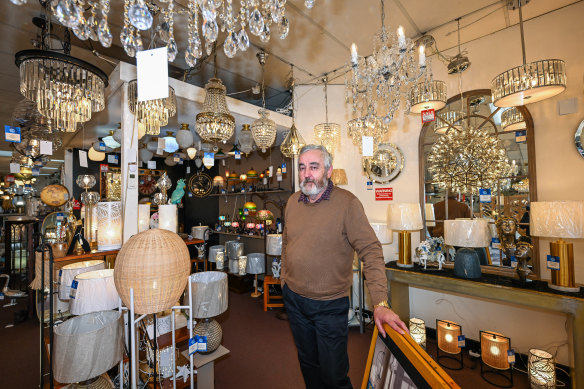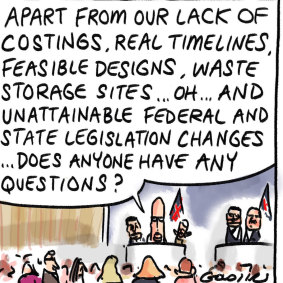This was published 9 months ago
The political fault lines spoiling Dutton’s nuclear plans in Victoria
By Benjamin Preiss, Josh Gordon and Kieran Rooney
Nuclear power stations will probably never be built in Victoria even if Peter Dutton’s Coalition wins the next federal election, with Premier Jacinta Allan vowing to do everything she can to block them and even the state opposition stopping short of backing Dutton’s plan.
Allan said on Wednesday that she would not negotiate with any future Dutton-led government over his plan to put a nuclear power plant on the site of the Loy Yang coal-fired power stations at Traralgon in the Latrobe Valley.

The Coalition plans to build a nuclear reactor on the coal-fired site near Traralgon if it wins the next election.Credit: Joe Armao
“I oppose a nuclear power plant in Victoria. Should the Coalition win the next [federal] election, I’ll be doing everything in my power to stop it,” Allan wrote in a letter to the federal opposition leader on Wednesday.
“I won’t be negotiating. I won’t allow a lurch backwards to nuclear power that sends bills skyrocketing, nor will I allow the Latrobe Valley to become your dumping ground.”
Dutton also can’t count on support from fellow Liberal John Pesutto, as the state opposition leader told Victorians he had no plans to introduce nuclear power.
“Our focus is on the looming and current shortfalls in energy supply in Victoria,” Pesutto said.

Premier Jacinta Allan has written to Peter Dutton opposing his nuclear plan.Credit: Chris Hopkins
“All of the experts we speak to are telling us gas can fulfil that role.”
Pesutto grew up in the Latrobe Valley and his father was an electrician at the Yallourn power station.
“I anticipate there will be a long and detailed discussion with all Australians, in particular for our purposes here in Victoria, the people of Gippsland,” he said.
On Wednesday, Dutton announced a plan – based on the Coalition winning the next election – to build seven nuclear power plants across mainland Australia on the sites of former coal power plants at Lithgow and the Hunter Valley in NSW, Loy Yang in Victoria, Tarong and Callide in Queensland, Collie in Western Australia and Port Augusta in South Australia. He said they would all be operating by 2050.

Wendy Farmer from Voices of the Valley. The group rallied outside their federal MP’s office on Wednesday.Credit: Joe Armao
Wendy Farmer, a spokeswoman for the Voices of the Valley community group, said there would be strong anger in the Latrobe Valley region if a nuclear plant were built.
She said many residents would be worried about how waste would be handled and the prospect of something going wrong that could trigger a nuclear emergency.
“We are not a dumping ground,” she said.
Farmer also raised concerns about stability and vulnerability to disaster given the fault line underneath Traralgon.
Geoscience Australia mapping data shows a number of significant fault lines in the Latrobe Valley, including a “definite neotectonic feature” running directly past the Loy Yang A power station.
But Dr Adi Paterson, a former chief executive of the Australian Nuclear Science and Technology Organisation, said reactors on fault lines – such as the one at Koeberg in South Africa – were built on foundations with seismic bearings. He said they used standard technology for other buildings in earthquake zones to absorb the impacts.
Seismic risk could be eliminated for reactors and doing so did not significantly alter the cost of construction, he said.
“I have stood under the reactor at Koeberg and looked at the bearings, and it’s the same technology at all seismically active plants around the world,” Paterson said.

Latrobe Mayor Darren Howe says the community needs more details about the nuclear plan.Credit: Joe Armao
Farmer, whose husband worked at the former Hazelwood power station, said there was little chance a nuclear plant could begin operating at Loy Yang by the 2030s.
“It’s a ridiculous idea, a fantasy that has no detail, no plans,” she said of the Coalition’s proposal.
On Wednesday, Farmer led a small rally outside the Traralgon electorate office of federal Nationals MP Darren Chester, calling on the opposition to abandon the nuclear proposal.
Latrobe Mayor Darren Howe said the ground was stable around Loy Yang, but the planned plant’s location was one of many factors that needed examination.
The community needed clear information and to be consulted about the Coalition’s nuclear plans, he said. “It’s important they know the facts.”
Many Traralgon residents and leaders believe the Latrobe Valley desperately needs to attract new industries and create more jobs, particularly after the closure of the Hazelwood coalmine and power station in 2017.
Bruce Bell, owner of lighting shop Light and Shade, said the closure of coal-fired power plants in coming decades and the recent loss of forestry-related jobs meant the region had to attract new employers.
Bell said the Latrobe Valley was already equipped to accommodate power generation, so it made sense to put a plant on the site of former coal-fired stations.
“All the power lines come here,” he said. “We’ve got heavy industry that’s designed around the power stations.”
Traralgon resident and businessman David Clark wanted more detail about the plan.
“Certainly people want the job opportunities,” he said. “But you say the word ‘nuclear’ and it starts to bring up some divisions.”
Former economist and Traralgon resident Nigel Purchase opposed the plan and said a nuclear power plant was unlikely to materialise.

Traralgon business owner Bruce Bell says the Latrobe Valley needs to attract more employers.Credit: Joe Armao
“I don’t think it’s going to happen because it’s too expensive,” Purchase said.
Australia needed to make greater use of renewable energy resources, he said.
“What you want is something you can produce cheaply in a factory, like solar panels or wind turbines.”

Credit: Matt Golding
When asked whether he would promise Victorians that he would not support the removal of the state’s moratorium on nuclear energy, Pesutto, the state opposition leader, called on the media to “change politics” and not “play those games”.
“You’re getting well ahead of yourselves. We have no plans for it; I cannot be any clearer than that, but we acknowledge that a future federal government may initiate that discussion,” he said.
Victorian Nationals leader Peter Walsh said his party had the same view as the state Liberals.
“The Victorian Nationals haven’t been [campaigning for nuclear]. We are very much of the view that we want to make sure that we guarantee price of power, the affordability of power, the availability of power in the short to medium term, which is why we’ve been talking about the need for more gas into the system,” Walsh said.
Seismology Research Centre chief scientist Adam Pascale said the risk of an earthquake in the Latrobe Valley would certainly need to be considered if engineering a nuclear power facility.
“That part of Victoria is above average in its seismicity. There are faults everywhere, whether you have managed to map them or not,” he said.
Pascale said while Australia was a geologically stable continent, an earthquake with a maximum magnitude of 7.5 was possible.
“If we had a magnitude 7.5 very close to a facility, then it would be a big problem. The Turkey earthquakes from the start of last year were around that sort of magnitude. You’d need a very engineered structure to withstand that sort of shaking at closer range,” he said.
Dr Tamarah King, an earthquake hazard scientist at Geoscience Australia, said building a nuclear facility on a fault line would require more study.
“The International Atomic Energy Agency, of which Australia is a member state, provide strict and rigorous regulations and guidelines for scientifically quantifying seismic hazard at a local scale for nuclear power plants and other nuclear facilities,” she said.
“This includes detailed identification and characterisation of potentially capable faults which may pose a risk to the facility over its lifetime.”
With Mike Foley
Get the day’s breaking news, entertainment ideas and a long read to enjoy. Sign up to receive our Evening Edition newsletter here.